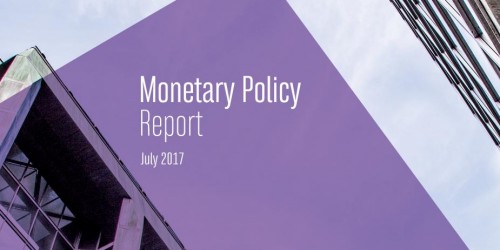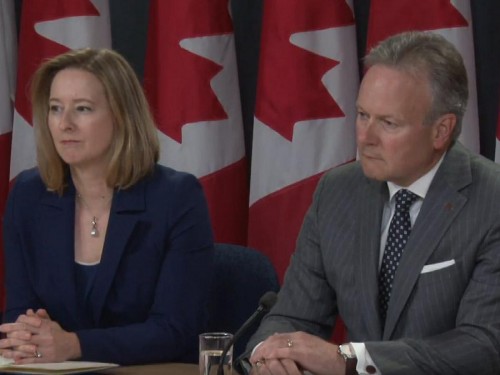Monetary Policy Report Press Conference Opening Statement
Good morning. Senior Deputy Governor Wilkins and I are pleased to be here to answer your questions about today’s interest rate announcement and our Monetary Policy Report (MPR).
Today, we raised our key policy rate by 25 basis points, in the context of an economy that is approaching full capacity and with inflation expected to reach the 2 per cent target within the next year.
Before we turn to your questions, let me offer some insights into the deliberations of Governing Council.
Economic data have been encouraging over the past few months, globally and especially for Canada. We acknowledged this positive trend in our April MPR and in our May 24 press release, while noting concern about the sustainability of growth because of its composition, as well as US-based policy uncertainties. While uncertainties remain, delays in decision making in the United States seem to have moved some of those concerns more into the background. The Bank’s latest Business Outlook Survey, for example, finds very strong business sentiment, particularly for investment and hiring intentions, despite a lack of clarity about future US policies.
Since April, we have also seen further evidence of a broadening of growth in Canada. Along with stronger-than-expected growth, this has bolstered Governing Council’s confidence in the outlook for the economy and inflation. The economy is absorbing excess capacity more rapidly than we projected in April, and it now appears that the output gap will close around the end of this year.
That will nevertheless leave some slack in the labour market. As output growth continues to exceed potential, we expect companies to invest in additional capacity and draw from this slack in the labour market, thereby expanding potential output further. This process is difficult to forecast but is likely to become increasingly evident as we approach full potential. This is an important reason why monetary policy is not on a predetermined path. It will remain highly data-dependent as we move forward. One key indicator of progress will continue to be wage inflation, which has shown signs of a pickup in recent months but remains restrained by the lingering effects of the adjustment to low oil prices.
Meanwhile, inflation has continued to fluctuate in the bottom half of our target range. This has prompted a lively debate, not just in Canada but in many other countries, about the appropriate interest rate setting when economic growth is rapid but inflation is low. Governing Council examined this issue closely from two perspectives.
The first asks whether there are special factors that are temporarily pushing inflation lower, and we discuss this issue in a technical box in the MPR. Generally speaking, central banks prefer to look through temporary factors. Of course, our new core measures of inflation were developed to help us see through the noise in inflation data, but even these are not immune to temporary fluctuations.
After careful assessment of the evidence, Governing Council agreed that a significant portion of the recent softness in our measures of inflation should prove to be temporary. Nevertheless, even a one-time price change affects inflation for a year, simply because we gauge inflation on a year-over-year basis. Some temporary factors are themselves gradual rather than one-off, such as increased competition in retail food stores. This all serves to underscore the data-dependent nature of monetary policy.
All things considered, Governing Council judges that in the absence of temporary factors, inflation would be running at around 1.8 per cent, as excess capacity in Canada is estimated to account for an inflation shortfall of about 0.2 per cent. Accordingly, as the gap closes in the months ahead, we expect inflation to head toward 2 per cent, with the rate of convergence determined by how quickly these various temporary factors unwind.
Our projection shows a modest overshoot of the 2 per cent inflation target in 2019. This is a product of the dynamics of our model, but it is an important reminder that, while our target is 2 per cent, our control range is a symmetric
1 to 3 per cent. Having a target range acknowledges the uncertainty inherent in economic forecasting and inflation control. The chances of an overshoot will depend on how investment and potential output respond to tighter capacity constraints, a process that the Bank will monitor closely.
The second perspective on the low-inflation issue concerns the lags between monetary policy actions and their ultimate effects on inflation. It is worth remembering that it can take 18 to 24 months for a monetary policy action to have its full effect on inflation. This means that central banks must target future inflation by anticipating future deviations from target. And because inflation is measured with a lag, reacting only to the latest inflation data would be akin to driving while looking in the rear view mirror. In contrast, imagine a world where the Bank was able to anticipate all future movements in inflation, and adjust interest rates in advance to offset them and keep inflation exactly at 2 per cent. In such a case, it might appear to the casual observer that interest rates were being adjusted up or down for no reason.
Taking together the approaching closing of the output gap and our understanding of recent soft inflation readings, today’s increase in interest rates is clearly warranted. That being said, we will of course monitor the details of inflation carefully to determine the extent to which it remains appropriate to look through fluctuations in inflation.
Interest rates were lowered in 2015 in order to help the economy adjust to lower oil prices, and much of that adjustment is now behind us. While lower rates contributed to greater household financial vulnerabilities, enhanced macroprudential policies helped to mitigate these and will continue to do so. As the economy approaches full capacity, a higher policy rate in pursuit of our inflation target also serves to reinforce efforts to mitigate financial system vulnerabilities.
Governing Council acknowledges that the economy may be more sensitive to higher interest rates than in the past, given the accumulation of household debt. We will need to gauge carefully the effects of higher interest rates on the economy.
Future adjustments to the target for the overnight rate will be guided by incoming data as they inform the Bank’s inflation outlook, keeping in mind continued uncertainty and financial system vulnerabilities.
With that, Senior Deputy Governor Wilkins and I will be happy to take your questions.


